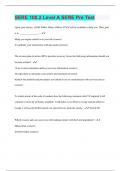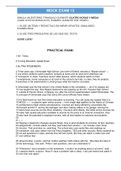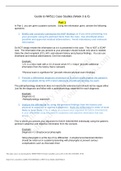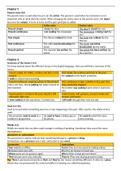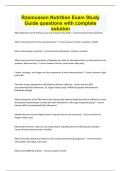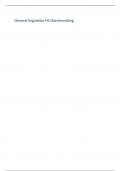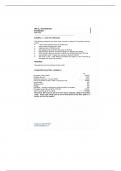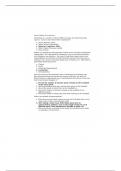Inhoudsopgave
1 Inleiding tot market response models ..................................................................................................... 4
1.1 Model building steps: ........................................................................................................................... 4
1.1.1 Specification .................................................................................................................................... 4
1.1.2 Estimation ....................................................................................................................................... 5
1.1.3 Testing and validation ..................................................................................................................... 5
1.1.4 Application ...................................................................................................................................... 5
1.2 Product-harm crises (Cleeren et al. 2013) ............................................................................................ 6
1.2.1 Specification .................................................................................................................................... 6
1.2.2 Estimation ....................................................................................................................................... 6
1.2.3 Testing and validating ..................................................................................................................... 7
1.2.4 Application ...................................................................................................................................... 7
1.3 De modeling gap .................................................................................................................................. 7
1.4 Hoe modeling papers lezen? ................................................................................................................ 7
1.5 Toepassen op het bovenstaand artikel ................................................................................................ 8
1.5.1 Onderzoeksvraag ............................................................................................................................. 8
1.5.2 Conceptual framework .................................................................................................................... 8
1.5.3 Data and modeling .......................................................................................................................... 8
1.5.4 Resultaten ....................................................................................................................................... 8
1.5.5 Reflection ........................................................................................................................................ 8
1.6 Inleiding model building: coca cola case .............................................................................................. 8
2 Advertising .............................................................................................................................................. 9
2.1 Hoe goed werkt advertising? (Sethuraman et al., 2011) ..................................................................... 9
2.2 Meta analyses ...................................................................................................................................... 9
2.3 Elasticiteiten ......................................................................................................................................... 9
2.4 Modeling paper lezen toegepast op Sethuraman et al., 2011 (5 stappen) .......................................... 9
2.4.1 Onderzoeksvragen .......................................................................................................................... 9
2.4.2 Conceptual framework .................................................................................................................... 9
2.4.3 Data and modeling ........................................................................................................................ 10
2.4.4 Resultaten ..................................................................................................................................... 11
2.4.4.1 Resultaten modererende effect .......................................................................................... 11
2.4.5 Reflectie......................................................................................................................................... 12
2.5 Het directe en indirecte effect van advertising (Joshi and Hanssens 2010) ....................................... 12
2.5.1 Onderzoeksvraag ........................................................................................................................... 12
2.5.2 Conceptual framework .................................................................................................................. 12
2.5.3 Data en methodologie ................................................................................................................... 13
2.5.4 Resultaten ..................................................................................................................................... 14
2.5.5 Reflectie......................................................................................................................................... 15
3 Online advertising ................................................................................................................................. 16
3.1 De online wereld ................................................................................................................................ 16
3.2 Impact van online en offline advertising op online en offline verkopen (Dinner et al, 2014) ............. 16
3.2.1 Onderzoeksvraag ........................................................................................................................... 16
3.2.2 Conceptual framework .................................................................................................................. 16
3.2.3 Data & methodologie .................................................................................................................... 17
3.2.4 Resultaten ..................................................................................................................................... 18
1
, 3.2.5 Reflectie......................................................................................................................................... 19
3.3 Online reviews .................................................................................................................................... 19
3.4 Meta-analyse van eWOM (You et al, 2015) ....................................................................................... 19
3.4.1 Onderzoeksvraag ........................................................................................................................... 19
3.4.2 Conceptueel framework ................................................................................................................ 20
3.4.3 Data en methodologie ................................................................................................................... 20
3.4.4 Resultaten ..................................................................................................................................... 21
3.4.5 Reflectie......................................................................................................................................... 22
4 Het verband tussen online, regionale en nationale reclame en de firm value (Sridhar et al, 2016) (Team
1) 23
4.1 Onderzoeksvraag ............................................................................................................................... 23
4.2 Conceptueel framework ..................................................................................................................... 23
4.3 Data en methodologie ....................................................................................................................... 24
4.4 Resultaten .......................................................................................................................................... 25
4.5 Reflectie.............................................................................................................................................. 25
5 Product ................................................................................................................................................. 26
5.1 Artikel 1 (Sood and Tellis 2009) .......................................................................................................... 26
5.1.1 Resultaten ..................................................................................................................................... 27
5.1.2 Reflectie/main findings ................................................................................................................. 28
5.2 Artikel 2 (Steenkamp and Gielens 2003) ............................................................................................ 29
5.2.1 Onderzoeksvraag ........................................................................................................................... 29
5.2.2 Conceptual framework .................................................................................................................. 29
5.2.3 Data en methodologie ................................................................................................................... 30
5.2.3.1 Fase 1: hazard model ........................................................................................................... 30
5.2.3.2 Fase 2: between-product effects ......................................................................................... 31
5.2.4 Resultaten ..................................................................................................................................... 33
5.2.5 Reflectie......................................................................................................................................... 33
5.3 Artikel 3 (team 2) New Product success in the consumer packaged goods industry: a shopper
marketing approach ......................................................................................................................................... 34
5.3.1 Onderzoeksvragen ........................................................................................................................ 34
5.3.2 Conceptueel framework ................................................................................................................ 34
5.3.3 Data en methodologie ................................................................................................................... 35
5.3.4 Resultaten ..................................................................................................................................... 36
5.3.5 Reflectie......................................................................................................................................... 39
6 Prijs ....................................................................................................................................................... 39
6.1 Het effect van prijs (Bijmolt et al. 2005) ............................................................................................ 39
6.1.1 Onderzoeksvraag:.......................................................................................................................... 39
6.1.2 Conceptual framework .................................................................................................................. 41
6.1.3 Data and modeling ........................................................................................................................ 41
6.1.4 Resultaten ..................................................................................................................................... 41
6.1.5 Reflectie......................................................................................................................................... 42
6.2 Internationale verschillen in prijssensitiviteit (Kubles, Pauwels, Yildirim and Fandrich 2018) ........... 42
6.2.1 Onderzoeksvragen ........................................................................................................................ 42
6.2.2 Data & methodologie .................................................................................................................... 42
6.2.3 Resultaten ..................................................................................................................................... 43
6.2.4 Reflectie......................................................................................................................................... 44
6.3 Referentieprijzen (mazumdar and sinha, 2005) ................................................................................. 44
2
, 6.4 Team 3: Investors’ evaluations of price-increase preannouncements (Lim, L.G., Tuli, K.R., Dekimpe
M.G. 2018) ........................................................................................................................................................ 45
6.4.1 Onderzoeksvraag ........................................................................................................................... 45
6.4.2 Conceptual framework .................................................................................................................. 45
6.4.3 Data en methodologie ................................................................................................................... 46
6.4.4 Resultaten ..................................................................................................................................... 47
7 Prijspromoties ....................................................................................................................................... 47
7.1 Prijspromoties (Gedenk et al., 2010) .................................................................................................. 47
7.2 Wie heeft het meest baat bij prijspromoties? (Srinivasan et al. 2004) .............................................. 49
7.2.1 Onderzoeksvragen ........................................................................................................................ 49
7.2.2 Conceptual framework .................................................................................................................. 49
7.2.3 Data en methodologie ................................................................................................................... 49
7.2.4 Reflectie......................................................................................................................................... 51
7.3 Price promotions and popular events (Keller et al., 2018) ................................................................. 52
7.3.1 Onderzoeksvragen ........................................................................................................................ 52
7.3.2 Conceptual framework .................................................................................................................. 52
7.3.3 Data en methodologie ................................................................................................................... 53
7.3.4 Resultaten ..................................................................................................................................... 56
8 Customer lifetime value ........................................................................................................................ 59
8.1 Customer lifetime value ..................................................................................................................... 60
8.1.1 Customer profit vs CLV .................................................................................................................. 60
8.1.2 Conceptual framework voor modelleren van CLV ........................................................................ 60
8.2 Balancing acquisition and retention resources to maximize customer profitability (Reinartz et al.,
2005) 61
8.2.1 Conceptual framework .................................................................................................................. 61
8.2.2 Data en methodologie ................................................................................................................... 61
8.3 Groepswerk 3: .................................................................................................................................... 65
8.3.1 CLV berekenen voor de gemiddelde klant .................................................................................... 65
8.3.2 CLV berekenen voor elke klant...................................................................................................... 65
8.3.3 Klanten heterogniteit .................................................................................................................... 66
9 Distributie ............................................................................................................................................. 66
9.1 (Avery et al. 2012) .............................................................................................................................. 66
9.1.1 Model: difference model ............................................................................................................... 68
9.2 Zijn multichannel consumenten meer waardevol? (Kushwaha and Shankar 2013) .......................... 69
9.2.1 Onderzoeksvragen ........................................................................................................................ 69
9.2.2 Conceptual framework .................................................................................................................. 70
9.2.3 Data en methodologie ................................................................................................................... 70
9.2.4 Resultaten ..................................................................................................................................... 72
3
, 1 Inleiding tot market response models
Verminderde invloed van marketing:
- Marketingfunctie lager in hiërarchie
- Strategische beslissingen worden genomen in andere departementen
- Marketing wordt gezien als kost
Wat zijn de bekwaamheden die de invloed van marketing bepalen? (Verhoef and Leeflang
2009)
Market response models:
- Linken van input variabelen aan output maatstaven
- Wat de impact is van marketingbeslissingen op output variabelen zoals verkopen,
marktaandeel, …
- Kwantificeren van marketing problemen
Voordelen van gebruik market response models:
- Betere beslissingen en beter begrip hoe de omgeving werkt
- Verbeteren data verzameling en hoe beslissing nemers hiermee omgaan
- Vaststellen veranderingen in omgeving
1.1 Model building steps:
1: Specification
2: Estimation
3: Testing and validation
4: Application
Leeflang, Peter S.H., Dick R. Wittink, Michel We del and Philippe A. Naert (2000).
Building Models for Marketing Decisions. Kluwer Academic Publishers.
1.1.1 Specification
Inputs:
- Marketing decision variables
- Independent variables
Outputs:
- What is the target?
- Dependent variables
Environmental factors:
- Other factors that influence the output
- Control variables
4
1 Inleiding tot market response models ..................................................................................................... 4
1.1 Model building steps: ........................................................................................................................... 4
1.1.1 Specification .................................................................................................................................... 4
1.1.2 Estimation ....................................................................................................................................... 5
1.1.3 Testing and validation ..................................................................................................................... 5
1.1.4 Application ...................................................................................................................................... 5
1.2 Product-harm crises (Cleeren et al. 2013) ............................................................................................ 6
1.2.1 Specification .................................................................................................................................... 6
1.2.2 Estimation ....................................................................................................................................... 6
1.2.3 Testing and validating ..................................................................................................................... 7
1.2.4 Application ...................................................................................................................................... 7
1.3 De modeling gap .................................................................................................................................. 7
1.4 Hoe modeling papers lezen? ................................................................................................................ 7
1.5 Toepassen op het bovenstaand artikel ................................................................................................ 8
1.5.1 Onderzoeksvraag ............................................................................................................................. 8
1.5.2 Conceptual framework .................................................................................................................... 8
1.5.3 Data and modeling .......................................................................................................................... 8
1.5.4 Resultaten ....................................................................................................................................... 8
1.5.5 Reflection ........................................................................................................................................ 8
1.6 Inleiding model building: coca cola case .............................................................................................. 8
2 Advertising .............................................................................................................................................. 9
2.1 Hoe goed werkt advertising? (Sethuraman et al., 2011) ..................................................................... 9
2.2 Meta analyses ...................................................................................................................................... 9
2.3 Elasticiteiten ......................................................................................................................................... 9
2.4 Modeling paper lezen toegepast op Sethuraman et al., 2011 (5 stappen) .......................................... 9
2.4.1 Onderzoeksvragen .......................................................................................................................... 9
2.4.2 Conceptual framework .................................................................................................................... 9
2.4.3 Data and modeling ........................................................................................................................ 10
2.4.4 Resultaten ..................................................................................................................................... 11
2.4.4.1 Resultaten modererende effect .......................................................................................... 11
2.4.5 Reflectie......................................................................................................................................... 12
2.5 Het directe en indirecte effect van advertising (Joshi and Hanssens 2010) ....................................... 12
2.5.1 Onderzoeksvraag ........................................................................................................................... 12
2.5.2 Conceptual framework .................................................................................................................. 12
2.5.3 Data en methodologie ................................................................................................................... 13
2.5.4 Resultaten ..................................................................................................................................... 14
2.5.5 Reflectie......................................................................................................................................... 15
3 Online advertising ................................................................................................................................. 16
3.1 De online wereld ................................................................................................................................ 16
3.2 Impact van online en offline advertising op online en offline verkopen (Dinner et al, 2014) ............. 16
3.2.1 Onderzoeksvraag ........................................................................................................................... 16
3.2.2 Conceptual framework .................................................................................................................. 16
3.2.3 Data & methodologie .................................................................................................................... 17
3.2.4 Resultaten ..................................................................................................................................... 18
1
, 3.2.5 Reflectie......................................................................................................................................... 19
3.3 Online reviews .................................................................................................................................... 19
3.4 Meta-analyse van eWOM (You et al, 2015) ....................................................................................... 19
3.4.1 Onderzoeksvraag ........................................................................................................................... 19
3.4.2 Conceptueel framework ................................................................................................................ 20
3.4.3 Data en methodologie ................................................................................................................... 20
3.4.4 Resultaten ..................................................................................................................................... 21
3.4.5 Reflectie......................................................................................................................................... 22
4 Het verband tussen online, regionale en nationale reclame en de firm value (Sridhar et al, 2016) (Team
1) 23
4.1 Onderzoeksvraag ............................................................................................................................... 23
4.2 Conceptueel framework ..................................................................................................................... 23
4.3 Data en methodologie ....................................................................................................................... 24
4.4 Resultaten .......................................................................................................................................... 25
4.5 Reflectie.............................................................................................................................................. 25
5 Product ................................................................................................................................................. 26
5.1 Artikel 1 (Sood and Tellis 2009) .......................................................................................................... 26
5.1.1 Resultaten ..................................................................................................................................... 27
5.1.2 Reflectie/main findings ................................................................................................................. 28
5.2 Artikel 2 (Steenkamp and Gielens 2003) ............................................................................................ 29
5.2.1 Onderzoeksvraag ........................................................................................................................... 29
5.2.2 Conceptual framework .................................................................................................................. 29
5.2.3 Data en methodologie ................................................................................................................... 30
5.2.3.1 Fase 1: hazard model ........................................................................................................... 30
5.2.3.2 Fase 2: between-product effects ......................................................................................... 31
5.2.4 Resultaten ..................................................................................................................................... 33
5.2.5 Reflectie......................................................................................................................................... 33
5.3 Artikel 3 (team 2) New Product success in the consumer packaged goods industry: a shopper
marketing approach ......................................................................................................................................... 34
5.3.1 Onderzoeksvragen ........................................................................................................................ 34
5.3.2 Conceptueel framework ................................................................................................................ 34
5.3.3 Data en methodologie ................................................................................................................... 35
5.3.4 Resultaten ..................................................................................................................................... 36
5.3.5 Reflectie......................................................................................................................................... 39
6 Prijs ....................................................................................................................................................... 39
6.1 Het effect van prijs (Bijmolt et al. 2005) ............................................................................................ 39
6.1.1 Onderzoeksvraag:.......................................................................................................................... 39
6.1.2 Conceptual framework .................................................................................................................. 41
6.1.3 Data and modeling ........................................................................................................................ 41
6.1.4 Resultaten ..................................................................................................................................... 41
6.1.5 Reflectie......................................................................................................................................... 42
6.2 Internationale verschillen in prijssensitiviteit (Kubles, Pauwels, Yildirim and Fandrich 2018) ........... 42
6.2.1 Onderzoeksvragen ........................................................................................................................ 42
6.2.2 Data & methodologie .................................................................................................................... 42
6.2.3 Resultaten ..................................................................................................................................... 43
6.2.4 Reflectie......................................................................................................................................... 44
6.3 Referentieprijzen (mazumdar and sinha, 2005) ................................................................................. 44
2
, 6.4 Team 3: Investors’ evaluations of price-increase preannouncements (Lim, L.G., Tuli, K.R., Dekimpe
M.G. 2018) ........................................................................................................................................................ 45
6.4.1 Onderzoeksvraag ........................................................................................................................... 45
6.4.2 Conceptual framework .................................................................................................................. 45
6.4.3 Data en methodologie ................................................................................................................... 46
6.4.4 Resultaten ..................................................................................................................................... 47
7 Prijspromoties ....................................................................................................................................... 47
7.1 Prijspromoties (Gedenk et al., 2010) .................................................................................................. 47
7.2 Wie heeft het meest baat bij prijspromoties? (Srinivasan et al. 2004) .............................................. 49
7.2.1 Onderzoeksvragen ........................................................................................................................ 49
7.2.2 Conceptual framework .................................................................................................................. 49
7.2.3 Data en methodologie ................................................................................................................... 49
7.2.4 Reflectie......................................................................................................................................... 51
7.3 Price promotions and popular events (Keller et al., 2018) ................................................................. 52
7.3.1 Onderzoeksvragen ........................................................................................................................ 52
7.3.2 Conceptual framework .................................................................................................................. 52
7.3.3 Data en methodologie ................................................................................................................... 53
7.3.4 Resultaten ..................................................................................................................................... 56
8 Customer lifetime value ........................................................................................................................ 59
8.1 Customer lifetime value ..................................................................................................................... 60
8.1.1 Customer profit vs CLV .................................................................................................................. 60
8.1.2 Conceptual framework voor modelleren van CLV ........................................................................ 60
8.2 Balancing acquisition and retention resources to maximize customer profitability (Reinartz et al.,
2005) 61
8.2.1 Conceptual framework .................................................................................................................. 61
8.2.2 Data en methodologie ................................................................................................................... 61
8.3 Groepswerk 3: .................................................................................................................................... 65
8.3.1 CLV berekenen voor de gemiddelde klant .................................................................................... 65
8.3.2 CLV berekenen voor elke klant...................................................................................................... 65
8.3.3 Klanten heterogniteit .................................................................................................................... 66
9 Distributie ............................................................................................................................................. 66
9.1 (Avery et al. 2012) .............................................................................................................................. 66
9.1.1 Model: difference model ............................................................................................................... 68
9.2 Zijn multichannel consumenten meer waardevol? (Kushwaha and Shankar 2013) .......................... 69
9.2.1 Onderzoeksvragen ........................................................................................................................ 69
9.2.2 Conceptual framework .................................................................................................................. 70
9.2.3 Data en methodologie ................................................................................................................... 70
9.2.4 Resultaten ..................................................................................................................................... 72
3
, 1 Inleiding tot market response models
Verminderde invloed van marketing:
- Marketingfunctie lager in hiërarchie
- Strategische beslissingen worden genomen in andere departementen
- Marketing wordt gezien als kost
Wat zijn de bekwaamheden die de invloed van marketing bepalen? (Verhoef and Leeflang
2009)
Market response models:
- Linken van input variabelen aan output maatstaven
- Wat de impact is van marketingbeslissingen op output variabelen zoals verkopen,
marktaandeel, …
- Kwantificeren van marketing problemen
Voordelen van gebruik market response models:
- Betere beslissingen en beter begrip hoe de omgeving werkt
- Verbeteren data verzameling en hoe beslissing nemers hiermee omgaan
- Vaststellen veranderingen in omgeving
1.1 Model building steps:
1: Specification
2: Estimation
3: Testing and validation
4: Application
Leeflang, Peter S.H., Dick R. Wittink, Michel We del and Philippe A. Naert (2000).
Building Models for Marketing Decisions. Kluwer Academic Publishers.
1.1.1 Specification
Inputs:
- Marketing decision variables
- Independent variables
Outputs:
- What is the target?
- Dependent variables
Environmental factors:
- Other factors that influence the output
- Control variables
4

